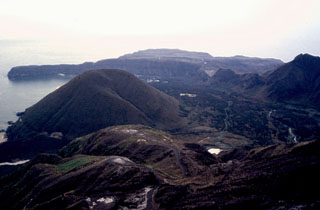Report on Kikai (Japan) — 25 April-1 May 2018
Smithsonian Institution / US Geological Survey
Weekly Volcanic Activity Report, 25 April-1 May 2018
Managing Editor: Sally Sennert.
Please cite this report as:
Global Volcanism Program, 2018. Report on Kikai (Japan) (Sennert, S, ed.). Weekly Volcanic Activity Report, 25 April-1 May 2018. Smithsonian Institution and US Geological Survey.
Kikai
Japan
30.793°N, 130.305°E; summit elev. 704 m
All times are local (unless otherwise noted)
JMA reported that the number of volcanic earthquakes at Satsuma Iwo-jima, a subaerial part of Kikai’s NW caldera rim, was low during 20-26 April. White plumes rose as high as 700 m above the Iwo-dake lava dome; incandescence from the crater had not been visible since 12 April. During field surveys on 25 and 26 April observers noted a slight expansion of a thermally anomalous area compared to 24-25 March observations, and a decrease in sulfur dioxide flux from 600 tons/day on 24 March to 300 tons/day. The Alert Level was reduced to 1 (on a 5-level scale) on 27 April.
Geological Summary. Multiple eruption centers have exhibited recent activity at Kikai, a mostly submerged, 19-km-wide caldera near the northern end of the Ryukyu Islands south of Kyushu. It was the source of one of the world's largest Holocene eruptions about 6,300 years ago when rhyolitic pyroclastic flows traveled across the sea for a total distance of 100 km to southern Kyushu, and ashfall reached the northern Japanese island of Hokkaido. The eruption devastated southern and central Kyushu, which remained uninhabited for several centuries. Post-caldera eruptions formed Iodake (or Iwo-dake) lava dome and Inamuradake scoria cone, as well as submarine lava domes. Recorded eruptions have occurred at or near Satsuma-Iojima (also known as Tokara-Iojima), a small 3 x 6 km island forming part of the NW caldera rim. Showa-Iojima lava dome (also known as Iojima-Shinto), a small island 2 km E of Satsuma-Iojima, was formed during submarine eruptions in 1934 and 1935. Mild-to-moderate explosive eruptions have occurred during the past few decades from Iodake, a rhyolitic lava dome at the eastern end of Satsuma-Iojima.

